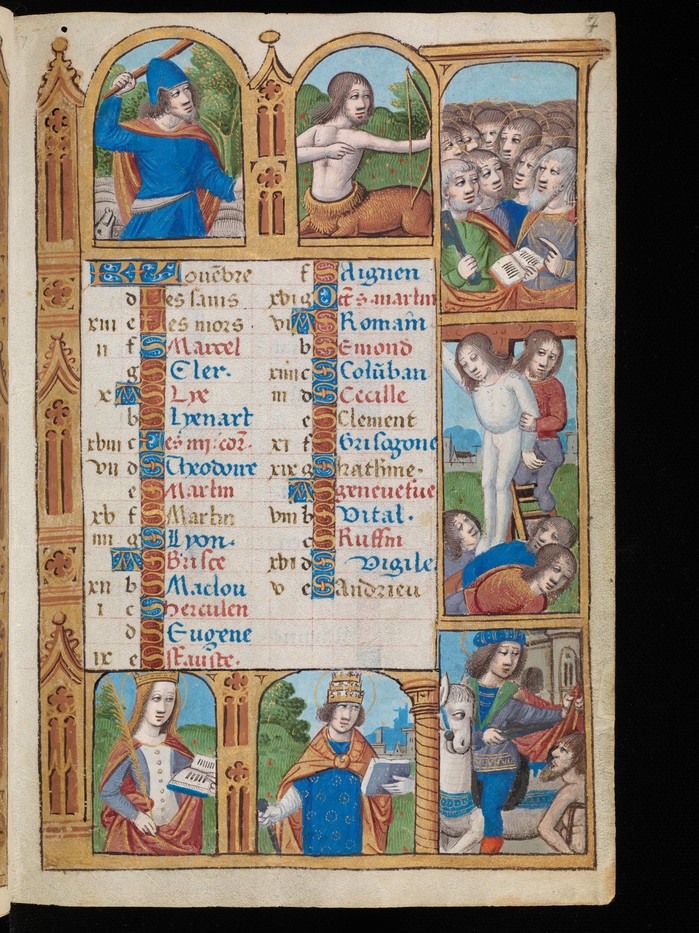Utopia Cod.111 is one of the many Parisian Hours, but with an unusual pedigree. King Charles VIII was a voracious bibliophile, and so was often gifted manuscripts by those wishing to curry favor. One of these is Cod.111, given by the parisian bookseller Anthoine Vérard about 1488, is an exquisite manuscript and the eponymous work of it’s illuminator, the Master of Charles VIII. It it completely illuminated, with every page having, at minimum, a vegetal border with Old Testament scenes inset in the outer margin. Throughout are full page miniatures. Many are the usual Life of Mary sequence, but some are more inventive, such as an opening depicting the Genealogy of Christ, from Adam through the Jesse on 14v and Jesse through Mary to Christ on 15r.
The calendar is equally lavish in decoration, with 2-columns of feasts set within a architectural border populated with the sign of the zodiac, the labor of the month and various Saints. The scribal work was not well coordinated with the illumanation, with multiple instances of the capitol “s” in a column where the feast is not for a Saint. This lack of communication continues in the month names, each of which is missing the first letter.
The entries are in the common Parisian color scheme, red/blue for common and gold for high-importance feasts. The entries are almost all identifiable, but riddled with errors, usually coming in blocks. For example for the thirteen entries in November 7-19, ten are on the wrong date. Interestingly in that block, the Feast of St Martin of Tours 2872 is on the wrong date but the Octave 2971 is correct. It seems like this block was shifted around to permit two saints with the same date to be included, but in an overly complex scheme (see f.7r below)
(Db ID: 259)

The Utopia, armarium codicum bibliophilorum collection (roughly translates to bookshelf of book-lovers) hosted at e-Codices is the location for privately-held manuscripts who’s owners allowed them to be digitized, but do not wish to be known. From that two books have been recently added, cod.109 and cod.111. Both of these are mid-15th century manuscripts from France, but after that they are distinctly different.
Cod.109 is from Angers, once the capitol of Anjou and about 300km from Paris, and dates from about 1430. It isn’t an unusually beautiful hours, but nicely executed with bright colors and wide borders filled with tiny leaves. The calendar is mostly full, with about 50 empty dates, though there is not a single feast with 2 different saints, not even the common pairing of St. James 1761 and St. Christopher 1757 on July, 25. The error rate is pretty low, only 18, but they seem to come in groups. Some unusual saints seem to reflect the uncommon use, such as St Gratian 3418 (in red) on October 23.
(Db ID: 260)
Back to Bibliothèque de Genève manuscripts, hosted by the excellent e-Codices. MS Lat 367 is a book made in Lyon for the Use of Geneva, which is an uncommon liturgical localization. It dates to the early 16th century, but post 1511 as some of the illustrations by the Maître de l’Entrée de François I are based on images in Durer’s 1511 Petite Passion.
The calendar is not complete, but nearly so with 359 entries and a few non-feasts indicated, such as “Dies Egyptia” on March 28. The entries have some accuracy issues, with at least 12 on the wrong date. There’s also an interesting scribal error in September (see f.10r below), where Cornelius and Cyprianus (3696) are listed on both the 14th, the correct date, and on the 13th as well. Many of the identified saints are unique or rarely seen in other calendars.
(DB Id: 249)

The other digitized hours from the Comites Latentes collection of the Bibliothèque de Genève, hosted by the excellent e-Codices site, was made in Tours for a customer from Toulouse, Comites Latentes 124. Two of the miniatures are by Jean Bourdichon, the rest by the workshop of the equally distinguished Jean Poyer.
The calendar is rather unusual on the page. The ruling is more complex than usual, with seven ruled columns, the main set off with double-lines. The saints are in black, with gold for the important and red for vigils, but most of the gold has flaked off. The Egyptian Verses and the name of the month are in silver, which has aged very well with little loss or oxidization. The entries are very accurate, with only 6 of 240 unknown and a few more unidentified. An unusual, actually unique so far, entry is the Vigil for Candlemass 4212.
(DB Id: 240)
From the Bibliothèque de Genève, hosted by the excellent e-Codices site, comes a late 15th Florentine Book of Hours, Comites Latentes 54. The book is in a very careful and decorative Italian Gothic, with a couple of the highly-ornate borders that often accompany this scribal hand. The calendar is mosthly empty, with only 128 total entries, about 1/2 ranked high. As common in Italian books there’s a high-than-usual count of popes, and some specific local entries, such as the rare St. Zenobious of Florence 4072.
(DB Id: 239)
From a new source, the Archives of the Canton of Vaud, comes a nice Parisian Book of Hours, shelfmark P. Château de La Sarraz H 50. As a Swiss Cantonal library, this manuscript is comprehensively catalogued and digitized in e-Codices. Helpfully for localization and dating, this has a colophon* on f. 193v stating that it was made in the workshop of the Parisian bookseller Jacquet Lescuier in 1421 and bought, though possibly not comissioned, by Jean II de Gingins.
The calendar is not terribly unusual for a Parisian complete calendar, with just red and black entries. There are some errors, but no more than expected with a complete calendar. A couple of the entries are unclear due to the gothic biting.
(DB Id: 237)
* Ces heures sont a Jehan de gingins seigneur duione et capitaine surgens darmes pour le roy nostre sire. Et furent faites a larue neufue n[ost]re dame par iaquet lescuier. Lan .mil.CCCC.XXI.

